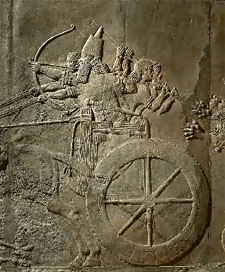 Men have always dreamed or imagined about jostling obstacles, and about winning over the enemy’s resistance through terror or crushing him under an irresistible moving mass. Just remember
the Sumerian combat tanks (5,000 b.c.) or the
Egyptian ones(3,000 b.c.),or Persian ones, which hubs and saft were equippped with dummies,
the Elephants of Hannibal (heavy beasts protected by thick carapaces mounted with a wooden tower where the archers stood), or else the
cavalry charges, until the moment the horse is not anymore physically able to carry a cuirasse made to resist to the new weapons of that period, i.e. the gun and the rifle.
Men have always dreamed or imagined about jostling obstacles, and about winning over the enemy’s resistance through terror or crushing him under an irresistible moving mass. Just remember
the Sumerian combat tanks (5,000 b.c.) or the
Egyptian ones(3,000 b.c.),or Persian ones, which hubs and saft were equippped with dummies,
the Elephants of Hannibal (heavy beasts protected by thick carapaces mounted with a wooden tower where the archers stood), or else the
cavalry charges, until the moment the horse is not anymore physically able to carry a cuirasse made to resist to the new weapons of that period, i.e. the gun and the rifle.
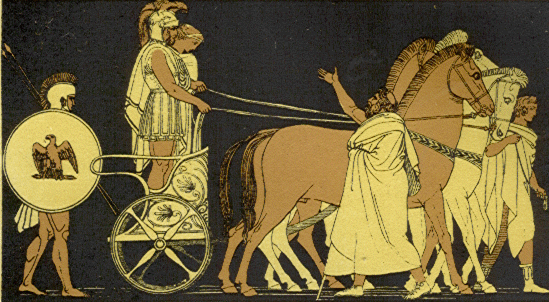
The origine of the
combat tank in thus very old (middle age tank); hence even the Bible, under versets 1 to 16 of Chapter of the Book of Judges mention them : “ 1. Once Ehoud dead, the sons of Israël started again to do what is wrong to the eyes of the Lord. 2. The Lord sold them to Yavïn, king of Canaan, which reigned in Hacor. The Chief of his army was Sisera who lived at Harosheth-Goïm. 3. The sons of Israël screamend towards the Lord, for Sisera had nine hundred chariots of iron (combat tanks) and this badly oppressed the sons of Israël during twenty years.”
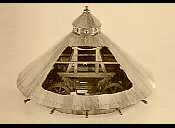
Nonetheless, quite a few centuries later, idea of the powerful protected engine that was able to move on any terrrain while remaining broadly unvulnerable had not vanished. Leonardo Da Vinci wrot on 1482 to Ludovic Sforza that he was building “at the moment vehicles secure and closed that are unvulnerable and when they move forward witht their weapons no ennemy can resist. Behind the infantry can come safely without meeting any opposition” (XVIII th tank). Leonardo da Vinci is besides the inventor of the modern Combat tank, so alike the physionomie of his invention was to the one of the present tanks.
 Four centuries later,
the car
made its officiel entry into the French army in 1897, date of the creation of the military commission of cars presided over by the Col. Feldmann, Director to the Technical Section of the Artillery.
Four centuries later,
the car
made its officiel entry into the French army in 1897, date of the creation of the military commission of cars presided over by the Col. Feldmann, Director to the Technical Section of the Artillery.
Futher to important tests of use concerning 1,630 vehicles in two years, the army purchases its first vehicles in 1899 near manufacturers like Panhard and Levassor, Maison Parisienne, Peugeot...For the army, the process of its motorization and mecanization has started. At the beginning limited to the fast liaisons of the Staff and to certain reconnaissances, the process of mecanization will gather quick momentum thanks to inventive spirits who will see into the cars a new mean of combat and who will think to arm it and to protect it. After the first armoured cars from Captain Genty in 1904, the Charron armoured car in 1906 will be the first French armoured vehicle used during the manoeuvers.
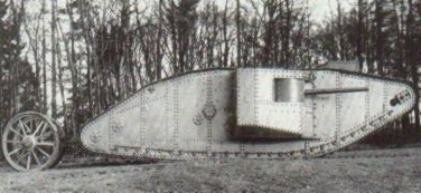 Nonetheless, the first deployment of such vehicles, that used that kind of continued tracks and steel plates as protection, took place during the battle of Somme, in France, on September 15th, 1916. It is there that 32 Mark 1
tanks to part to the attack, and some of them contributed to the seizure of the village of Flers. The Schneider, Saint-Chamond or MarkV* will later take over, before they got replaced by the FT 17.
Nonetheless, the first deployment of such vehicles, that used that kind of continued tracks and steel plates as protection, took place during the battle of Somme, in France, on September 15th, 1916. It is there that 32 Mark 1
tanks to part to the attack, and some of them contributed to the seizure of the village of Flers. The Schneider, Saint-Chamond or MarkV* will later take over, before they got replaced by the FT 17.
 The prototype of the Renault FT 17 was finalized on October, 1916. The father of the armoured cars, Gen. Estienne, obtained very quickly from Field Marshal Joffre the authorization to order the manufacturing of 1,000 10-ton tanks, armed with a 7.62 mm machine gun, or for some of them with a little 37 mm gun located into the turret. This light tank was the most spread tank in WWI and equipped every allied army. In total 8,000 units were manufactured, among which 3,940 by RENAULT. It average 15 mm armouring only protected it from the shots from the individual weapons of that time. It was actually equipped with a 35 HP 4 cylinders in line RENAULT engine that was propelling it at a maximum 8.5 km/p.h. speed and for a 35km autonomy.
The prototype of the Renault FT 17 was finalized on October, 1916. The father of the armoured cars, Gen. Estienne, obtained very quickly from Field Marshal Joffre the authorization to order the manufacturing of 1,000 10-ton tanks, armed with a 7.62 mm machine gun, or for some of them with a little 37 mm gun located into the turret. This light tank was the most spread tank in WWI and equipped every allied army. In total 8,000 units were manufactured, among which 3,940 by RENAULT. It average 15 mm armouring only protected it from the shots from the individual weapons of that time. It was actually equipped with a 35 HP 4 cylinders in line RENAULT engine that was propelling it at a maximum 8.5 km/p.h. speed and for a 35km autonomy.
The use of armoured combat vehicles in armed conflicts has kept on without a pause since WWI, and wide deployments of armoured forces were used during and after WWII.
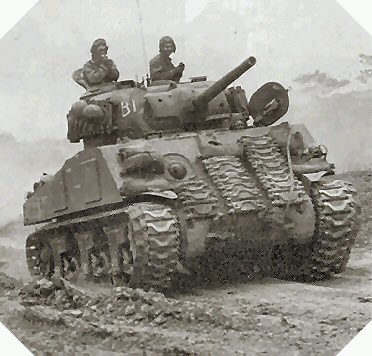 The prototype of the
SHERMAN M4 was implemented in March, 1941. From the fore-project to the first deliveries, only 13 months had passed. The M4 is to be considered as one of the most beautiful industrial successes of all times. On April, 1945, 48,071 of them were delivered, belonging to thirty or so different kinds. This medium 30-ton tank was the most common on WWII and equipped all the allied armies. It was armed with a 75 mm gun and eventually with a 12.7 mm machine-gun as well as two 7.62 mm submachine-guns, its average 50 mm armouring protected it efficiently from every small calibre weapons of that time. Actually, it was equipped with a R.975 Continental star-shaped 9-cylinder, 450 HP engine that propelled it to a maximum 45 km/p.h.
The prototype of the
SHERMAN M4 was implemented in March, 1941. From the fore-project to the first deliveries, only 13 months had passed. The M4 is to be considered as one of the most beautiful industrial successes of all times. On April, 1945, 48,071 of them were delivered, belonging to thirty or so different kinds. This medium 30-ton tank was the most common on WWII and equipped all the allied armies. It was armed with a 75 mm gun and eventually with a 12.7 mm machine-gun as well as two 7.62 mm submachine-guns, its average 50 mm armouring protected it efficiently from every small calibre weapons of that time. Actually, it was equipped with a R.975 Continental star-shaped 9-cylinder, 450 HP engine that propelled it to a maximum 45 km/p.h.
After the ending of the hostilities in 1945, the political slump caused by the cold war lead the NATO member nations and the ones from the Warsaw Pact to deploy on both sides enormous mechanized and armoured forces in Central Europe.
On both sides, the most feared vehicle has become the Main Battle Tank (MBT), which versions in the year 1960 weighed about 40 tons. Those tanks were equipped with a 90 or
105 mm gun and with a powerful 800 to 1,000 HP engine that propelled them at 60 kms/p.h.
One could have deducted that the combat tank had reached its maturity and that no major evolution was to occur. This is totally false. Of course, by the appearance, the present tanks do not basically differ from their post-war ancestors. But the technology has dramatically transformed the armoured combat, bringing to the vehicles increased capacities.
First and foremost, the fear of the MDW lead the designers to protect the armoured vehicles against radiations and bacteriological as well as chemical weapons. The present BMT can then combat in complete Nuclear-Bacteriological-Chemical atmosphere.
Later, the combat tanks which at the beginning were just vehicles that carried a weapon have become devices of integrated weapons having an embarked computer liking each tank with its unit and even with the staff, the laser telemeter took over from the optical systems, an embarked calculator determines the optimal angle of shot in function of information provided by temperature, wind speed and hygrometry gauges. On the most recent types, a stabilizer allows a moving shot with a more elevated precision than on halt upon the models of the ‘60s, an infra-red visualisation device allows the tanks to keep on fighting even during the night, while the former models had to stop, etc…
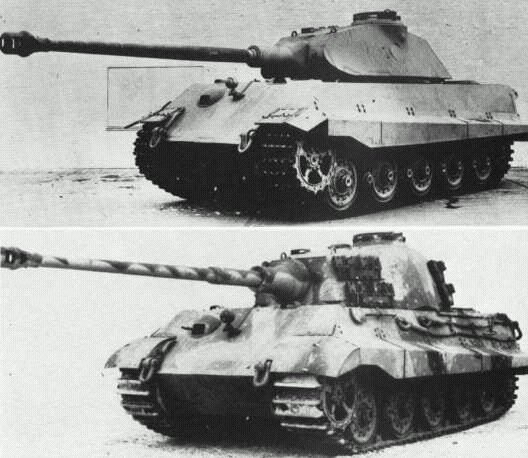 The gross fire power has also increased. The standard calibre of the present tanks’guns is threefold more performing than the ones of WWII, while the jets of fusion of the hollow charge shells or of the impoverished uranium (“arrow”)shells have a thirty-fold penetration force. It was reported that during WWII, the Kw.K.43 88 mm gun (L/71) that equipped
le Tiger II, Tiger II the most powerful German tank during the conflict, applied an impulsive charge of 1,644 MJ/sq.meter. At the end of the ‘70s, the NATO 105mm “arrow” shells with detachable shoe triggered a 7,800 MJ/sq.meter. Actually, nowadays, a 120 mm penetrating material as the M829A2 American shell with impoverished uranium develops a 35,800 MJ/sq. meter resulting energy applied to the target, yet, the IU ammo only improve the depth of penetration of 10% of a reinforced target of heavy armouring, if compared to the tungsten penetrating material.
The gross fire power has also increased. The standard calibre of the present tanks’guns is threefold more performing than the ones of WWII, while the jets of fusion of the hollow charge shells or of the impoverished uranium (“arrow”)shells have a thirty-fold penetration force. It was reported that during WWII, the Kw.K.43 88 mm gun (L/71) that equipped
le Tiger II, Tiger II the most powerful German tank during the conflict, applied an impulsive charge of 1,644 MJ/sq.meter. At the end of the ‘70s, the NATO 105mm “arrow” shells with detachable shoe triggered a 7,800 MJ/sq.meter. Actually, nowadays, a 120 mm penetrating material as the M829A2 American shell with impoverished uranium develops a 35,800 MJ/sq. meter resulting energy applied to the target, yet, the IU ammo only improve the depth of penetration of 10% of a reinforced target of heavy armouring, if compared to the tungsten penetrating material.
But it is at the protection’s level that the evolution may be the most interesting one. At the beginning of the tanks history, the armouring technology copied the one of the ships’ cuirassses. This latter encompassed the armour plates bound together with rivets. Now, said rivets turned out to be dangerous projectiles inside the vehicle when a projectile hit it. The armoured car resisted more or less but its crew was either wonded or killed by the explosion of the rivets. The fixing by rivets was then a problem The problem was that it was impossible to weld those steels due to the important part of carbon that entailed their strength and resistance. The armour plates were then replaced by molded armouring that present round forms, particularly remarkable on the turrets. Then the progress of metallurgy allowed the shifting to mecoan-welded armouring that at times used special alloys.
Nonetheless, rather than increasing even more the thickness of the steel plates that are called the laminated homogeneous armouring (LHA), or moulded steel, after 1945 the upcoming of the tilted armouring has doubled armour-plating’s resistance. While, during the ‘80s, the engineers have used several materials with different physical properties (ceramics, glass, composite…) with a view to improving the impact resistance.
The British then implemented the ‘Chobham’ armour-plating, twelve times more performing than the ordinary laminated armour-plating of the tanks from the prior generations. Likewise, the Israelis are implementing the active armour-plating in 1982: the tank is covered with explosive bricks that explode upon impact. The parasite explosion thwarts the formation of the fire-sting upon which all the penetrating power of the hollow charge shells relies.
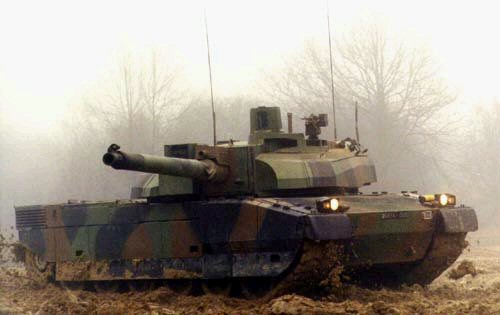 The present versions of the MBT weigh about 60 tons. They are equipped with an either 105 mm, 120 mm or 125 mm gun, and a multitude of secondary elements, with a 12 cylinder diesel engine or with a turbine that develops 1,500 HP, which propel engines to 80 kms/p.h., (as, say, the
Leclerc, the
Challenger, the
Abrams, the
Leopard 2 or else the
T 80) Moreover, the armouring (Chobbam, with a possibilitiy to add on top an active armouring) of modern tanks is quite complex and of various thickness. Actually, generally, the engine is protected but a rear 75mm armouring while the front of the turret is being reinforced by a
380 mm Chobbam armouring. (such armouring is often composed with neutralized or impoverished uraninium).
The present versions of the MBT weigh about 60 tons. They are equipped with an either 105 mm, 120 mm or 125 mm gun, and a multitude of secondary elements, with a 12 cylinder diesel engine or with a turbine that develops 1,500 HP, which propel engines to 80 kms/p.h., (as, say, the
Leclerc, the
Challenger, the
Abrams, the
Leopard 2 or else the
T 80) Moreover, the armouring (Chobbam, with a possibilitiy to add on top an active armouring) of modern tanks is quite complex and of various thickness. Actually, generally, the engine is protected but a rear 75mm armouring while the front of the turret is being reinforced by a
380 mm Chobbam armouring. (such armouring is often composed with neutralized or impoverished uraninium).
The impoverisehd uranium – or neutralized uranium – used in the military applications owns less than 0.2 % of U235. It is plated with steel with a view to minimizing the possibles risks of radiation.
Finally, the forepart of the chassis is often protected by less than 400 mm, the sides of the turret by 300 mm and the sides of the chassis by 200mm. The shaping of the tanks is designed to have the shells rebound and to increase the effective armouring with a 45° tilted armouring.
Nonetheless, here again, abroad like in France, new evolutions are upcoming, as the Leclerc 2015 project. Progresses in stealth are more particularly planned in the upcoming years. Then, in the scope of the new programs of defence, the technological evolutions will render the present operating versions of the MBT obsolete. As a matter of fact, the exponential increase of the swiftness of the technological evolution shortens the operational life of the different programs of armament.
As a consequence, for an army a material that is more than thirty years old does not show any operational military interest in view of the equipment of the opposite armies. Moreover, for the future, as regards the materials that are posterior to the ’70, in view of the importance taken by the IT and the electronics into those “weapon devices”, it will be practically impossible for a private collector to maintain such materials and more particularly to have them in a position to move.
In conclusion, it clearly appears that a collection vehicle that is more than thirty years old and, a fortiori, from WWI or WWII is totally and definitely outdated. Moreover, the very numerous civil and military authorities seek the participation of military collection vehicles during memorial ceremonies that are organized to pay tribute to the Veterans and Victims of wars.
Complementary informations about :
Ancestors :
- Charron 1902 Armored Car
- Charron 1906 Armored Car
WW I Tanks :
- Mark I tank
- Mark V tank
- Renault FT 17 tank
- Saint-Chamond 1917 tank
- Schneider CA-1 tank
- Sturmpanzerwagen A7V tank
Between Two Wars Tanks :
- FCM 2C 1921 Tank
- Peugeot-Kegresse 1923 Armoured Car
Cold War Tanks :
- M 47 PATTON tank
- AMX 13 tank
- T54/55 tank
Modern Tanks :
- LECLERC tank
- Léopard 2 tank
- M1 Abrams tank
|







